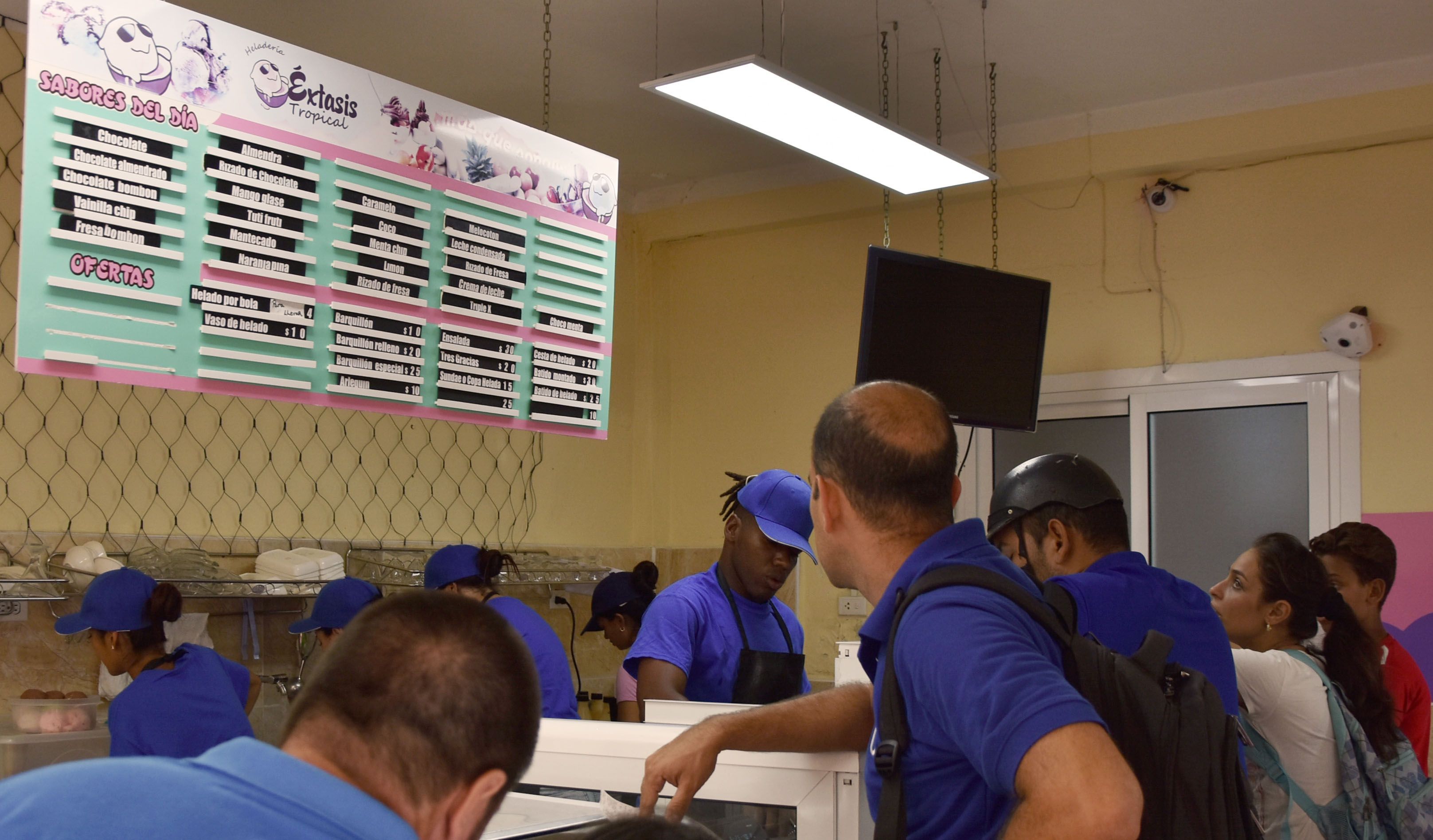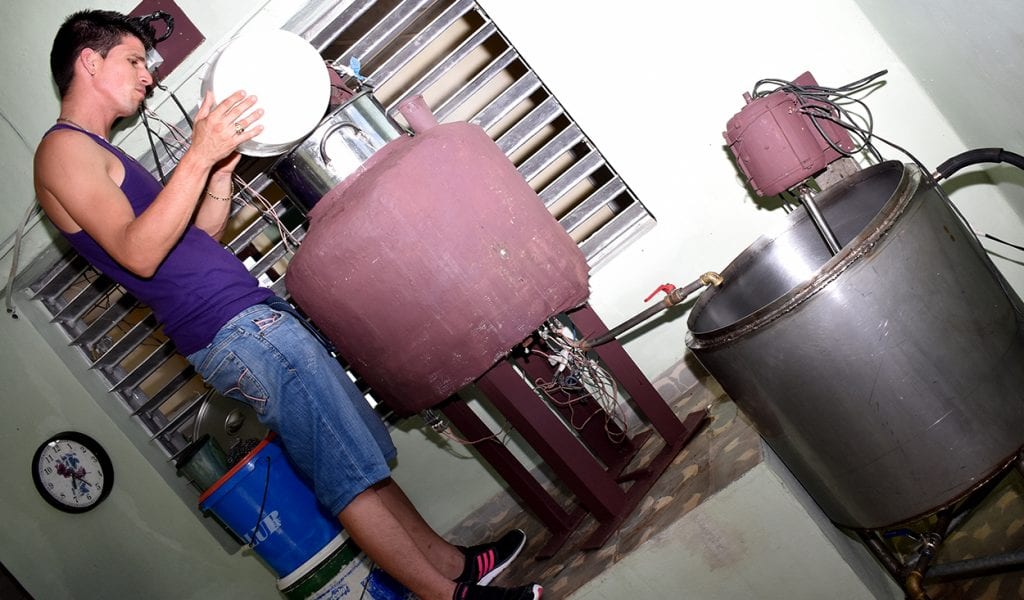Every morning, Julio travels the same route: he rides a bike along Tulipan Street, crosses Loma and then reaches Colon Avenue. For five years now, Julio has been casually riding through Nuevo Vedado selling ice-cream bars.
He buys the bars, covered in a thin layer of chocolate, from a small creamery that supplies street sellers and cafes in the neighborhood.
If a decade ago, ice cream production in Cuba was practically in the hands of state industry and the multinational Nestle company, this market has extended to the emerging private sector after the national market opened to some types of self-employment in 2010.
The only thing left of Coppelia (Cuba’s Cathedral of Ice Cream, which used to sell over 25 different flavors when it was opened to the public by Fidel Castro in 1966) is its extravagant architecture and symbolic prices (half a “leveled and compact” scoop costs 1 Cuban peso). Back then, every Cuban had access to the same creamy dessert, with no notable difference between workers or company managers.
This is how things were for over 40 years. Until 2003 when the country, in dire need of foreign capital, allowed multinational company Nestle to establish itself in partnership with the Cuban state-owned company Coral LLC. The multinational company was given local rights to produce ice-cream in Cuba, without any obvious competition in sight. This is how ice-cream began to be sold in hard currency CUC, ranging from 1-2.50 CUC per ice-cream.
Over recent years, some people have discovered that the island’s climate and the Cuban people’s passion for cold sweets is a lucrative business and have diversified supply, divided into different price ranges. Today, you can buy homemade ice-creams at affordable prices, from ice-cream parlors that sell them at mid-range prices (such as Extasis Tropical or El Barquillon in Havana) or even luxury gelati.

Heladería Éxtasis Tropical. Foto: Jorge Beltán.
Ice-cream according to your income
Gelatto, Amore and Helad’oro are privately-owned, comfortable ice-cream parlors where you can choose from twenty-something flavors (chocolate, tropical fruits, yoghurt, pistachio, mojito…). The menu is regularly updated and combinations can be served along with cake or stuffed croissants.
Half a scoop of ice-cream at any of these Italian-inspired ice-cream parlors costs approximately 20 times more than the same at Havana’s traditional Coppelia.
In spite of these blatantly high prices (a speciality there nearly always costs more than a “tub in CUC” sold by the mixed Nestle company), regular customers are mostly Cuban nationals.
There’s no wonder why: they go to these businesses looking for a superior product. “Our success lies in the exclusivity of our offers,” young business-owner Yanetsi Azahares says.
The owner of Gelatto learned how to make the creamiest of sweets while in Italy and then adapted her knowledge to local supply chains. The flavors in her large display cabinet change with the seasons. Both her and Pablo Fernandez (owner of Amore) agree that access to raw materials is the biggest problem they have with their businesses.
Using small industrial machines, they both need to buy most of their ingredients at local retail markets and they depend on the fruits that are being sold. “When you’ve been in this business for a couple of years, you know who the best suppliers are to get your supplies from. Plus, friends or family who leave the country always bring back some flavors we can’t find here in Cuba: pistachio, for example,” Yanetsi says.
These limitations also affect similar businesses in the country’s interior. In Iguara, a small town in the north of the Sancti Spiritus province, young business-owner Luis Manuel Alvarez opened “Cremeria Lulu”. Up until today, this is the only establishment that sells ice-cream there.
Ever since the beginning, Lulu opens at night and offers its customers a large salon, where families from Iguara can choose between a variety of flavors and eat them without the stress of having to wait in long lines.
Luis initially wanted to produce ice-creams at home, but when he realized that supplies were short, he decided to join some self-employed business owners and sell the ice-cream others produce at his own business.
These alliances help to overcome the obstacle that the government’s ban on importing equipment and supplies for commercial purposes creates.
The Italian machines that some of these establishments use have been purchased outside of Cuba and declared as a personal import at Customs.
In the face of such hurdles, some business owners have decided to innovate production with their own mini-industries.
Lester and his ice-cream machine

When Lester Concepcion was in the 5th year of his Mechanical Engineering degree at the Marta Abreu University of Las Villas, he wanted to build his own ice-cream machine.
Before this, he had seen another machine created by one of his friends, then he analyzed how industrial machines worked and he put the rest of his doubts to the Internet and found out what he needed to know.
After a year of trying to put it together, Lester managed to produce traditional flavors of ice-cream, such as chocolate and strawberry, as well as tropical fruits.
“You can make ice-cream out of anything. The hardest part is getting a hold of the ingredients. I produce 60 liters of ice cream in a day and then I don’t use the machine for a couple of days. It all depends on how consistent supplies are.”
Lester also built his own “heat exchanger” (to boil milk, cook and cool down the ice-cream) and some “Creole” freezers, fitted out with Haier fridge doors.
The engineer lives in Placetas, in the center of the country, and admits that he could create new machines and increase production, but, “why would I want another two or three machines, if I’m going to end up stopping anyway because there aren’t any ingredients? The market doesn’t provide us with the supplies we need. It would be unproductive.”
For now, the young business owner prefers to sell his desserts in bulk. He earns four Cuban pesos for every ice-cream or chocolate-covered ice-cream bar he sells. Others, such as bike seller Julio in Havana, take ice-cream to customers and this is how they complete a market cycle which benefits more than just one person.
* In this text they collaborated Emilio L. Herrera, Dorisbel Guillén, Leydis Hernández Lima and Ernesto J. Gómez Figueredo.
This article was translated by Havana Times from the original published in Spanish.










Comments
We moderate comments on this site. If you want to know more details, read our Privacy Policy
Your email address will not be published. Mandatory fields are marked with *